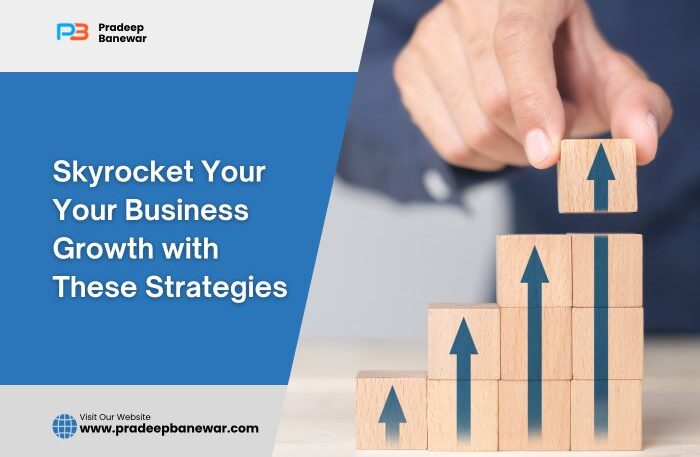Achieving sustainable growth is a top priority for businesses of all sizes and sectors in today’s increasingly competitive business environment. However, the road to growth is frequently paved with obstacles, requiring clear vision and the appropriate tactics to make that goal a reality. You’ll need this blog post, “Strategy Of Business Growth: Apply These 8 Secret Techniques To Improve Business,” to open the door to success.
Businesses must constantly adapt and innovate to survive this era of fast digital transformation and altering consumer preferences. While some growth strategies are well-known, several less well-known but very effective ways have helped countless businesses reach incredible heights. Though rarely acknowledged in formal corporate settings, these “secret” tactics can be crucial in determining one’s road to riches.
We will explore these eight well-kept secrets to give you practical advice. This business growth strategy will enable you to strengthen the foundations of your organization and put it on an accelerated growth trajectory. You can also use AI tools for digital marketing to grow your business. They range from understanding the subtleties of market segmentation to leveraging the power of innovation, successful marketing, and financial strength.
Join us on this trip as we uncover these untapped sources of business expansion, providing you with the information and resources you need to drive your company toward long-term success. These strategies will enable you to stay ahead in the always-changing business environment, regardless of your experience level.
Technique 1: Market Segmentation
A key idea in marketing is market segmentation, which includes breaking up a larger target market into more manageable groupings based on traits, habits, or demands that have in common. Businesses can maximize the relevance and efficacy of their products, services, and marketing initiatives by using this strategic approach to target particular segments with their offerings. Therefore, market segmentation is critical in business:

- Precision Targeting: Companies can develop highly targeted marketing efforts by understanding different customer groups’ characteristics and interests. This precision increases the likelihood of connecting with customers and generating conversions.
- Resource Efficiency: Businesses can more effectively distribute their resources by segmenting the market. They can concentrate their efforts and finances on the areas with the maximum potential for return on investment rather than using a one-size-fits-all business growth strategy.
- Customization: Improving consumer satisfaction by designing services or goods to fulfill the needs of different market segments. Long-lasting relationships and brand loyalty may result from this personalization.
- Competitive Advantage: Market segmentation can reveal niche or underdeveloped markets, giving opportunities to businesses to set themselves apart from competitors and establish a presence in specialized fields.
Businesses must do in-depth market research, analyze data, and gain a complete understanding of their customers to apply market segmentation efficiently. It’s a dynamic process that calls for ongoing evaluation and adjustment to shifting market circumstances.
Market segmentation is a powerful way for companies wishing to achieve sustainable growth and connect with their audience on a deeper level in the modern marketing world, where personalization and relevance are essential.
Technique 2: Customer Persona Development
Developing consumer personas is a strategic process that involves developing in-depth, somewhat fictional representations of your ideal clients. Companies find these personas invaluable for gaining a deeper understanding of their target market, focus marketing efforts, and achieve success. Here’s why it’s a crucial component of modern marketing:

- Enhanced Understanding: To better understand your target audience, it is essential to do in-depth research and data analysis before creating customer personas. Businesses can directly address the demands of their customers because of this genuine understanding.
- Targeted Messaging: Personas give businesses the tools to create highly customized and focused marketing communications. Businesses can better interact, and connect with their targeted audience by addressing particular issues and goals of each persona.
- Better Product creation: Customer personas direct the creation of products and services by emphasizing the benefits and features that appeal to the target market. It guarantees that products and services meet client expectations.
- Relevance of the content: Content marketing is more successful when it speaks directly to the concerns and interests of the personas. Businesses may successfully engage and educate their audience by creating content that addresses unique persona needs.
Research, interviews, and data analysis are required to produce accurate and helpful representations of customers. These personas should outline their psychographics, ambitions, pain points, and preferred means of contact.
Customer persona building is crucial for organizations wishing to engage with their audience on a deeper level, develop lasting relationships, and ultimately stimulate growth and success in today’s world where customers expect individualized experiences.
Technique 3: Competitive Analysis
Competitive analysis is a tactical technique that involves assessing and comprehending the advantages and disadvantages of your competitors in your business. It is crucial to the growth and planning of a corporation. Therefore, competitive analysis is critical:

- Making Knowledgeable Decisions: Businesses can learn about industry trends, consumer preferences, and new threats by researching their rivals. Businesses make strategic decisions based on this knowledge, which assists them in product development, pricing, and marketing.
- Identification of Gaps: Competitive analysis reveals market gaps that competitors may have missed. These holes offer chances for differentiation and innovation, enabling companies to differentiate themselves in the market.
- Performance Benchmarking: Compare the performance of your competitors to yours for a helpful benchmark. It enables you to establish sensible objectives, track your development, and pinpoint areas where you can beat competitors.
- Risk reduction: Recognising the competitive environment enables organizations to foresee and reduce potential risks. This assertive approach might avoid unpleasant surprises and better equip businesses to adjust to market developments.
Businesses gather information on their competitors’ goods, pricing plans, marketing initiatives, and customer feedback to conduct a comprehensive competitive analysis. There are multiple ways to collect this information, including market research, web sources, and industry studies.
Competitive analysis is an ongoing exercise in an ever-changing corporate environment. Regularly analyze competitors and modify plans to achieve long-term success and remain competitive. It is a tool that enables companies to achieve a competitive advantage and make data-driven decisions.
Technique 4: Innovation and Product Development
The intersection of innovation and product development is the engine that drives businesses toward growth and success in today’s fast-paced and intensely competitive business environment. Adopting innovation and consistently improving product offerings are essential for effective business growth.
- Maintaining Relevance: Businesses that decline risk becoming obsolete in a world where consumer preferences and technologies are constantly changing. Innovate to remain relevant and in line with changing consumer needs.
- Competitive Advantage: Cutting-edge products can give a clear-cut advantage. They enable you to determine your brand, grasp new market niches, and frequently fetch premium prices.
- Customer Satisfaction: Developing innovative products that address customer pain points and unmet needs promotes higher satisfaction and loyalty. Satisfied customers become brand advocates and fuel your company’s growth through positive word-of-mouth.
- Market Expansion: Innovative products open doors to new markets and demographics. They provide opportunities for diversification and expansion, reducing reliance on a single market segment.
- Operational Efficiency: Innovation isn’t limited to products alone; it can also streamline processes and enhance operational efficiency. It can save costs and improve business profitability.
Creating an environment that encourages experimentation and creativity is critical for effectively using innovation and product development to grow your business. Promote cooperation, make research and development investments, and monitor consumer preferences and market changes.
Product development and innovation are crucial elements and the forces that drive the expansion of your business. If you fully adopt them, you’ll find yourself on a path to increase your audience, please your clients, and ensure the future success of your business.
Technique 5: Effective Marketing and Branding
Effective branding and marketing are like the dynamic couple in corporate growth strategy, driving your company forward together. These crucial elements increase the size of your audience and promote consumer loyalty and brand recognition.
- Developing a Brand Identity: A successful brand identity extends beyond colors and logos. It describes the character, principles, and promise of your business. In addition to drawing in customers, a good brand identity helps your company stand out from the competition.
- Targeted Marketing: Marketing aimed at a target audience will increase the impact of your communications. Reaching the appropriate audience with the relevant message at the right time will maximize conversion and development opportunities.
- Building Trust: The foundation of any business partnership is trust. You may establish credibility and trust with your audience through continuous branding and open marketing, which is crucial for long-term growth.
- Customer Engagement: Effective marketing methods involve customers and invite them to participate in the development of your brand. Engaged clients suggest others to your business and purchase from you again.
- Adaptability and Innovation: Dynamic and adaptive marketing and branding tactics are essential. They change along with shifting consumer preferences and market trends, keeping your business relevant and competitive.
Identify your brand’s unique selling propositions, target market, and messaging to integrate effective marketing and branding into your company’s growth strategy. Utilize various offline and online marketing channels to reach your target, and track the effectiveness of your tactics to make data-driven adjustments.
Successful marketing and branding are the cornerstone of your company’s growth plan, not merely tools. They assist you in developing a unique brand identity, encouraging consumer engagement, and building trust, all of which eventually help your company achieve sustainable development and success.
Must Read: Digital Marketing Consulting Services: A Step-by-Step Guide to Choosing the Right One
Technique 6: Sales and Distribution Strategies
Developing efficient sales and distribution strategies is comparable to charting a path on a map for a corporation seeking to grow. These tactics assist you in getting there and guarantee that you do it successfully and profitably.
- Maximizing Market Reach: Sales and distribution strategies cover the channels and techniques used to get your goods or services in front of customers. You can expand your market reach and reach new client categories by carefully choosing and optimizing these channels.
- Enhancing Customer Convenience: Convenience is often a primary factor in purchasing decisions. Accessibility is a priority in efficient methods, and they make it as simple as possible for people to buy your items, improving the user experience and encouraging loyalty.
- Cost-Reduction: Effective distribution methods reduce warehousing, transportation, and inventory control expenses. In turn, this improves your bottom line and guarantees that you are optimizing profits in line with your plan for business expansion.
- Competitive Advantage: You can distinguish yourself from the competition by distributing your goods effectively. You might help stand out in the market and draw clients with customized distribution techniques that offer distinctive and practical purchasing experiences.
- Data-Driven Decision-Making: Modern sales and distribution tactics depend on data analytics to make wise judgments. It is known as “data-driven decision-making.” Businesses can improve their strategy for growth and remain flexible in a changing market by researching customer behavior and market trends.
Conduct thorough research of your target market, evaluate your competitors, and examine the advantages and disadvantages of different distribution channels to integrate sales and distribution strategies into your business growth strategy. Follow performance closely and be prepared to change as market conditions do.
Your overall strategy for business growth must include both sales and distribution techniques. To increase your market presence and finance it effectively, maximize these techniques. It will ensure a viable and fruitful expansion path.
Technique 7: Financial Management and Investment
Intelligent financial management and strategic Investments drive a company ahead in business growth. Here are some reasons why these elements are essential for carrying out a successful business growth strategy:
- Resource Allocation: Optimizing resource allocation is necessary for effective financial management. It ensures spending funds on expansion projects. It involves thoroughly evaluating the risks and potential rewards of numerous investment possibilities and coordinating them with your strategy.
- Risk Mitigation: Investments naturally involve risk, but with prudent money management, you can lessen the likelihood of setbacks. A key component of risk management is maintaining liquidity, diversifying investments, and having a backup plan.
- Initiatives for Growth Financing: Growth demands money, whether it’s for launching new products, opening new markets, or expanding operations. By ensuring that finance is available when needed, financial management avoids cash flow problems that can inhibit development.
- Performance Evaluation: Businesses can evaluate the effectiveness of their growth strategy through routine financial analysis. They monitor return on investment (ROI) and locate places where modifications are required.
- Sustainable Growth: A sound financial plan encourages sustainable growth. By preventing overextension and future financial crises, it makes sure that the company maintains its financial stability even as it grows.
Consider completing a thorough financial audit, finding opportunities for cost optimization, and developing key performance indicators (KPIs) to quantify financial success when incorporating financial management and investment into your strategy for business growth. Examine multiple investment opportunities, such as introducing new product lines or investigating mergers and acquisitions, while coordinating them with your growth goals.
Sound financial management and wise investment choices are essential for any successful business expansion plan. When properly managed, they provide the financial platform for growth ambitions, giving people the tools to make their dreams come true.
Technique 8: Scalability and Adaptability
Scalability and adaptability have become essential characteristics that distinguish profitable businesses from those that struggle to keep up in the ever-changing business market. These two characteristics are crucial in the dynamic business world of today for the following reasons:
Scalability:
This term describes a company’s capacity to grow and effectively meet rising demand without risking quality or substantially raising prices. Scalable companies are ready to take advantage of new growth possibilities as they present themselves.
- Meeting Increasing Demand: Companies with the ability to scale can quickly respond to rising demands for their goods or services in rapidly changing markets.
- Resource Efficiency: Scalability reduces the need to expand without using disproportionately more resources, such as infrastructure and workforce. Maintaining profitability during growth depends on this effective utilization of resources.
- Competitive Advantage: Scalability frequently translates into a competitive edge in the marketplace. Businesses that can quickly scale their operations can outsmart rivals and profit from new trends.
Adaptability:
On the other side, adaptability refers to a company’s ability to change with the times, markets, and customer preferences. Organizations must be adaptable to remain relevant and resilient in the uncertainty phase.
- Responding to Market Shifts: Adaptable Businesses can shift course when the market environment does. In reaction to changing consumer demands and preferences, it enables the launch of new products, services, or tactics.
- Crisis Resilience: Organizations that place a high priority on adaptability are better able to withstand crises and disruptions, regardless of whether they result from rapid technological development, economic downturns, or unforeseeable occurrences like the COVID-19 epidemic.
- Culture of Innovation: Adaptability encourages an innovative environment within enterprises. It motivates staff to use their imagination, try novel ideas, and constantly enhance procedures.
Scalability and adaptability require an evaluation of your business’s operations, a foresight of upcoming difficulties, and an acceptance of flexibility. Creating an organizational culture that values innovation and change is also necessary. In a world where change is the only constant, businesses that emphasize these attributes will succeed.
Business expansion is not just a desire in the complex world of entrepreneurship; it is a strategic undertaking that requires foresight, adaptation, and invention. This blog post, “Strategy Of Business Growth: Apply These 8 Secret Techniques To Improve Business,” digs into the underused resources that can drive your company from nominee to champion. These top-secret strategies are the instruments that give you the power to set your route, from the complexity of market segmentation to the accuracy of customer persona building, from the analytical brilliance of competition analysis to the inventive force of innovation.
Sales and distribution tactics open the door to your customers’ hearts, while effective marketing and branding give you a voice in the marketplace. Your ability to manage your money well and make wise investments is the foundation of your financial success.







